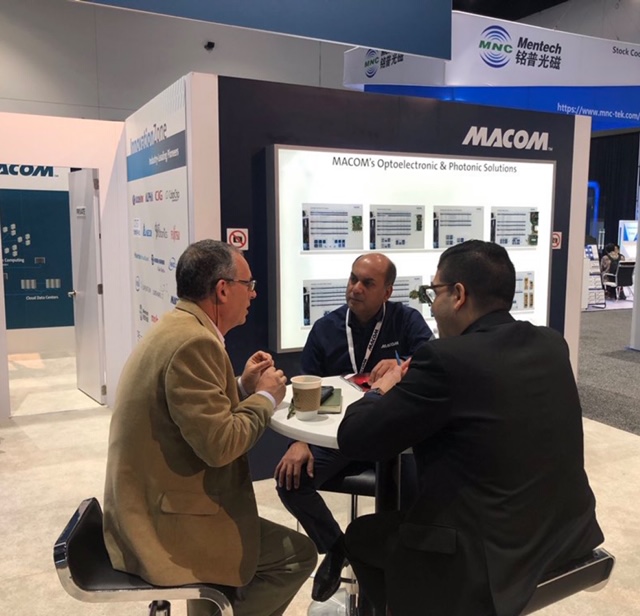Macom readies its silicon photonics platform for 400G
 Tuesday, April 16, 2019 at 9:12AM
Tuesday, April 16, 2019 at 9:12AM - Macom has announced a laser-integrated photonic integrated circuit (L-PIC) for the 400G-FR4 standard
- The company is also working with GlobalFoundries to use the semiconductor foundry’s 300mm wafer silicon photonics process
 Vivek Rajgarhia (centre) being interviewed at OFC. Source: Macom.
Vivek Rajgarhia (centre) being interviewed at OFC. Source: Macom.
Macom has detailed its latest silicon photonics chip to meet the upcoming demand for 400-gigabit interfaces within the data centre.
The chip, a laser-integrated photonic integrated circuit (L-PIC), was unveiled at the OFC show held last month in San Diego. The L-PIC implements the transmitter circuitry for the 400G FR4 2km interface standard.
Backing silicon photonics
“Five to six years ago, we saw that silicon photonics would have a key role to play in photonics and optical interconnect,” says Vivek Rajgarhia, senior vice president and general manager, lightwave at Macom.
Macom acquired several companies to gain the capabilities needed to become a silicon photonics player.
In 2014 the company paid $230 million for BinOptics which provided Macom with etched facet laser technology that plays a key role in how its L-PIC platform is assembled. Also acquired was the silicon photonics design company, Photonic Controls. In 2015 Macom added FiBest, a packaging specialist, for $60 million.
“We also have the electronics expertise to go alongside [the photonics] to provide chipset solutions,” says Rajgarhia.
Today, as a photonics company, if you don’t have a play in silicon photonics, you are legacy
Laser-integrated PIC
The biggest challenge in silicon photonics is integrating the laser, says Rajgarhia. Coupling and aligning the laser, especially when developing optical interfaces for the high-volume data centre market, needs to be done in a cost-effective and scalable way, he says.
The L-PIC, a coarse wavelength division multiplexing (CWDM) design, tackles this by having four cavities for the lasers. “Each laser is flip-chipped and inserted into a cavity without any lens or isolator, and without active alignment,” says Rajgarhia.
The self-alignment is possible by using the etched-facet laser technology from BinOptics. “When you cleave the laser facet, the dimensional control has a lot of play - the tolerance is very high - but with an etched facet, you lithographically define the mechanical dimensions,” he says. “We create a cavity in the silicon that matches the laser’s dimensions.” Macom has also incorporated multiple alignment structures as part of its L-PIC platform to enable the self-alignment.
Macom has already developed the L-PIC for the 100-gigabit CWDM4 standard. “We started with the CWDM4 because it had four wavelengths,” says Rajgarhia. “The CWDM4 is a more challenging design [than the 100-gigabit PSM4 interface] because it requires multiplexing.”
The L-PIC has now been extended to support 100-gigabit channels, to address the DR single channel and the four-channel 400-gigabit FR4 standards. The modulator bandwidth had to be extended and the laser power is different but the approach - the platform - remains the same, says Rajgarhia.
Macom refers to the L-PIC as a smart device. The electro-absorptive modulated lasers (EMLs) used for the FR4 are uncooled. The L-PIC includes ‘structures’ in the silicon such as heaters for tuning the optical elements and photo-detectors that monitor the optical performance. Macom has developed an accompanying micro-controller that sets and controls the device using such structures.
“We have developed software which we give to customers,” says Rajgarhia. “You can type in what extinction ratio you want, what power you want and it sets that up.”
The company has also started the FR4 receiver development that will also be an integrated design with a demultiplexer and four optical receiver channels.
Macom is not saying when the L-PIC will be available. However, the company says 'meaningful demand' for 400-gigabit interfaces will start from 2021.
GlobalFoundries
Macom also announced at OFC that it is working with GlobalFoundries to use the chip maker’s 90nm silicon-on-insulator 300mm wafer processing line.
“Today, as a photonics company, if you don’t have a play in silicon photonics, you are legacy,” says Rajgarhia, adding that in order to make money, what is needed is a working solution that can scale.
“When we started developing [silicon photonics devices], we and others used research foundries to get our products ready,” says Rajgarhia. “Now, what we have announced is that we are scaling this up at GlobalFoundries.”
Macom has started the development at GlobalFoundaries’ East Fishkill fab, the former IBM Microelectronics site that has undertaken a lot of research in silicon photonics, says Rajgarhia.
GlobalFoundries recently created a process development kit (PDK) for its silicon photonics line. Now Macom is an early user of the PDK.
Last year, silicon photonics start-up, Ayar Labs, entered into a strategic agreement with GlobalFoundries, providing the foundry with its optical input-output (I/O) technology while gaining access to its 45nm silicon photonics process.
 400G FR4,
400G FR4,  CWDM4,
CWDM4,  GlobalFoundaries,
GlobalFoundaries,  L-PIC,
L-PIC,  MACOM,
MACOM,  Vivek Rajgarhia in
Vivek Rajgarhia in  OFC 2019,
OFC 2019,  silicon photonics
silicon photonics  Print Article
Print Article 


Reader Comments